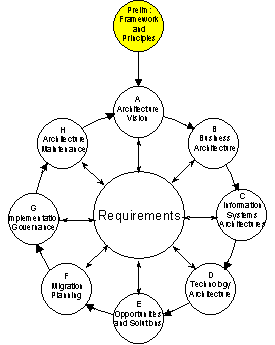[¤4]
 Objectives
Objectives

[¤3] Objectives Approach Inputs Steps Outputs
 Objectives
Objectives[¤12] This preliminary phase is about defining "How we do Architecture" in the enterprise concerned. There are two main aspects: defining the framework to be used; and defining the architecture principles that will inform any architecture work.
[¤13] The enterprise's approach to reuse of architecture assets is a key part of both the framework definition and architecture principles. (Typically the principles will state the policy on reuse; and the framework will explain how reuse is effected.)
[¤14] In federated architectures (see Enterprise Scope / Focus in the Introduction to the Architecture Development Method), requirements from a higher level architecture are often manifested as "principles" in lower level ones.
[¤16] The TOGAF Architecture Development Method is a generic method, intended to be used by enterprises in a wide variety of industry types and geographies. It is also designed for use with a wide variety of other enterprise architecture frameworks, if required (although it can be used perfectly well in its own right, without adaptation).
[¤17] This phase therefore involves doing any necessary work to adapt the ADM to define an organization-specific framework, using either the TOGAF deliverables or the deliverables of another framework. The issues involved in this are discussed under Adapting the ADM in the Introduction to the ADM.
[¤19] This phase also defines the architecture principles that will form part of the constraints on any architecture work undertaken in the enterprise. The issues involved in this are explained in Part IV, Architectural Principles.
(m_iacob) Put 'Architecture work complies with business
principles...' instead of 'Architecture work is informed by
business principles...'.
[¤20] Architecture work is informed by business principles as well as architecture
principles. The architecture principles themsleves are also normally based in part on
business principles. Defining business principles normally lies outside the scope of the
Architecture function. However, depending on how such principles are defined and
promulgated within the enterprise concerned, it may be possible for the set of
architecture principles to also restate, or cross-refer to, a set of business principles,
business goals, and strategic business drivers defined elsewhere within the enterprise.
(Within an architecture project, the architect will normally need to ensure that the
definitions of these business principles, goals, and strategic drivers are current, and to
clarify any areas of ambiguity.)
(m_iacob) Replace paramountcy with supremacy, or dominance , or with
something semantically equivalent.
(a_bodor) Replace 'paramountcy with leadership.
[¤21] The issue of architecture governance is closely linked to that of architecture
principles. The body responsible for governance will also normally be responsible for
approving the architecture principles; and the paramountcy of this body in resolving
architecture issues will normally be one of the principles cited. The issues involved in
governance are explained in Part IV, IT Governance.
[¤23] The inputs to this phase are:
[¤31] The TOGAF Architecture Development Method is a generic method, intended to be used by a wide variety of different enterprises, and in conjunction with a wide variety of other architecture frameworks, if required. It is not practical to define specific steps for adapting the ADM to such a wide variety of potential contexts. The issues involved are discussed in detail under Adapting the ADM in the Introduction to the ADM.
[¤33] The outputs of this phase are:
[¤37] Copyright © The Open Group, 2002